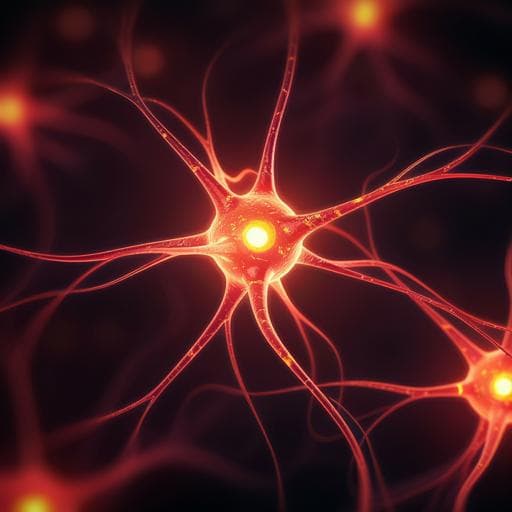
Medicine and Health
In-vivo integration of soft neural probes through high-resolution printing of liquid electronics on the cranium
Y. Park, Y. W. Kwon, et al.
Explore groundbreaking advancements in soft, conformable neural interfaces developed by authors including Young-Geun Park and Yong Won Kwon. This innovative system achieves long-term stability for monitoring single-unit neuronal activities, promising new insights into brain function.
~3 min • Beginner • English
Introduction
The brain is a three-dimensional, complex network of vast numbers of neurons whose activity controls body function, consciousness, and memory. Subtle abnormalities in neuronal activities can lead to neurological disorders such as epilepsy, Parkinson’s disease, Alzheimer’s disease, depression, and chronic pain. Implantable neural probes that transduce ionic neural signals to electronic signals have been developed to monitor neuronal activity in specific brain regions. However, conventional probes are based on solid materials (metals or silicon) with elastic moduli in the hundreds of GPa—orders of magnitude higher than that of brain tissue—leading to inflammatory responses and device migration after implantation. Soft electronics with mechanical properties similar to brain tissue can provide stable neural contacts and reduce immune responses during chronic implantation. Therefore, developing soft, tissue-conformable neural probes is key to forming reliable, minimally invasive interfaces with the brain and minimizing injury along the nonplanar curvature of the cranium for long-term interfacing.
Beyond the probes themselves, subsidiary electronics required for collecting and processing neural signals often remain flat, rigid PCBs made of solid, fragile materials, undermining integration with biological systems and restricting long-term use during free movement. Stretchable designs allow conformal lamination to curved body surfaces. Moreover, customizable structural designs are essential to accommodate individual variations in brain and cranium geometry and to place multiple probes across diverse regions. Current approaches for multi-region recording (e.g., multiple burr holes in SEEG, multi-shank probes, spatially expandable fiber probes) are limited by fixed device geometries. Direct printing approaches offer flexible, software-defined design changes, but prior integration of printed subsidiary electronics with soft neural probes directly on the cranium had not been demonstrated, and existing printable conductors often require thermal annealing or solvent drying, limiting printability on biological systems.
Literature Review
Prior work established that rigid, solid-material neural probes (metals, silicon) cause significant mechanical mismatch with brain tissue, eliciting inflammatory responses and probe migration. Soft/tissue-like electronics reduce immune responses and improve chronic stability. For multi-region recording, techniques include stereoelectroencephalography (SEEG) with multiple burr holes, multi-shank probes, and spatially expandable fiber probes; however, prefabricated devices with fixed geometries limit spatial variability. Printed/stretchable electronics can conform to curved anatomy, yet most printable conductors require drying/thermal annealing, unsuitable for live biological surfaces. Gallium-based liquid metals have high conductivity, negligible toxicity in recent studies, and can be printed without post-processing, suggesting promise for on-tissue biomedical circuits.
Methodology
Design and printing of soft neural probes: Eutectic gallium–indium (EGaIn, 75.5% Ga, 24.5% In) was used as a liquid-metal ink. A custom high-resolution direct-printing setup featured a nozzle (pulled glass capillary, inner diameter 5–60 µm; or plastic nozzles with 120–150 µm tips) connected to an ink reservoir, a pneumatic pressure controller (typically 50–60 psi during printing), and a 6-axis motion stage. Using a 5 µm inner diameter nozzle at 0.1 mm/s, EGaIn lines as narrow as 5 µm were printed; line width scaled approximately linearly with nozzle diameter. After printing 5 µm-wide EGaIn electrodes, parylene-C was deposited for passivation, leaving only the tip exposed. The electrode opening was ~5 µm wide and 7.5 µm high (exposed cylindrical surface area ~58.8 µm²). Platinum black (PtB) nanoclusters were electrodeposited selectively at the exposed tip (0.1 mA, 60 s in Pt salt solution) to increase electrochemical surface area and reduce impedance.
Mechanical and electrochemical characterization: Elastic moduli of parylene-coated EGaIn (Parylene/EGaIn) and PtB/EGaIn were measured via tensile testing, yielding 330 kPa and 233 kPa, respectively—orders of magnitude lower than solid silicon or gold and lower than PEDOT. Bending stiffness (~0.264 pN·m) was comparable to brain tissue. Self-healing was evaluated by stretching to induce disconnection (≈250% strain) and monitoring resistance; coalescence restored conductivity within ~10 s at ambient conditions. In saline, repeated disconnection/reconnection cycles (5x) showed negligible changes in impedance spectra.
Cranial printing and wireless circuitry: For in vivo conformal electronics, an anesthetized mouse was fixed to a rodent adapter mounted on the 6-axis stage. A thin medical-grade polymer (Loctite 4011) was first printed along the cranium to insulate/passivate the wet surface and cured (e.g., 30 µm layer cured in ~2 min). EGaIn was then 3D-printed directly on the curved cranial surface with ~5 µm tip–surface spacing and ~60 psi pressure, achieving 5 µm minimum line widths with complex geometries; typical printing velocity ~50–80 µm/s and total patterning times 12–22 min. Chips (e.g., NFC MCU, analog front-end, antenna) were mounted with silicone adhesive (Kwik-Sil), and 5 µm-diameter free-standing EGaIn 3D interconnects were printed to chip pads, eliminating soldering. Circuits were encapsulated with silicone to protect interconnects during skin closure and suturing. Wireless NFC recording used an analog front-end (ADS1201), NFC MCU (RF430FRL152H) with 14-bit ADC sampling LFPs at 153 Hz, and a chip antenna (W3102); power and data transfer were via smartphone proximity (~1.5–2 cm). For long-range recording, a commercial Wi‑Fi module (JAGA Penny) was connected through the printed cranial interconnects for single-unit acquisition at 20 kHz; working distance up to ~2 m in open space.
Monolithic integration and implantation: The neural interface system combined multiple printed soft probes and cranial interconnections. Implantation used a pulled glass capillary (50/70 µm ID/OD) loaded with probe in PBS; matching capillary retraction speed with syringe pump outflow allowed probe placement without displacement. Probes were fabricated to desired lengths so their proximal ends remained exposed on the cranium for printing interconnects. After printing interconnections from probe ends to electronics, silicone encapsulation was applied and scalp sutured.
Comparative and reliability testing: Signal quality was compared between monolithic EGaIn probe–EGaIn interconnect and heterogeneous EGaIn probe–Au interconnect using in vitro biphasic current pulses (0.5 mA, 0.2 ms pulse width, 0.02 ms interphase). The monolithic connection produced ~1.5× higher potentials with less waveform distortion. Single-unit SNR in vivo was compared between the printed system (soft probes + cranial electronics) and conventional Nichrome electrodes with PCB connectors, both interfaced to a Wi‑Fi module; SNRs averaged 5.977 vs 3.483, respectively. Mechanical stability was tested under 1 N compressive load on a curved sample with elastomer encapsulation; 3D interconnects remained intact. Accelerated aging of unencapsulated EGaIn interconnects bonded to NFC chips (75 °C for 7 days, ~7 months equivalent) showed negligible resistance change. Micro-CT imaging 6 weeks post-implantation confirmed intact traces.
Neural recording and analysis: Mice (male C57BL/6N or C3H) were used per IACUC-approved protocols. For multi-region recordings, 12 soft probes were implanted bilaterally in motor cortex (MO), hippocampus (HIP), and visual cortex (VIS) (specific stereotaxic coordinates provided). Wi‑Fi recording sampled at up to 24,414 Hz (LFP band 0.1–300 Hz; spikes 300–6000 or 500–3000 Hz; 60 Hz notch). PCA clustering, isolation distance, L-ratio, phase-locking analyses, and circular statistics were performed in MATLAB using standard toolboxes. Tissue clearing followed SHIELD; immunostaining assessed neurons (NeuN/anti-FOX3), astrocytes (GFAP), and microglia (Iba1). Cytotoxicity was evaluated by MTT and Calcein assays with media pre-incubated with EGaIn or PtB/EGaIn. Thermal measurements during wireless recording used infrared imaging.
Behavioral testing: A T-maze with distinct visual cues was used to study behavior-dependent neural activity. Two probes targeted CA1 (HIP) and L6 (VIS). Freely moving mice were tracked across trials, and LFPs/spikes were analyzed for running vs standstill and for head-rotation (left/right) epochs; phase-locking to theta and direction-dependent firing were evaluated.
Key Findings
- High-resolution liquid metal printing achieved 5 µm-wide soft neural probe electrodes with neuron-like dimensions; probe lengths were readily customized. The exposed electrode opening measured ~5 µm × 7.5 µm (area ~58.8 µm²).
- Electrode impedance: PtB-coated EGaIn (PtB/EGaIn) exhibited 415.0 kΩ at 1 kHz, about 3× lower than pristine EGaIn (1167.3 kΩ).
- Mechanics: Elastic moduli were 330 kPa (Parylene/EGaIn) and 233 kPa (PtB/EGaIn), drastically softer than solid electrodes; bending stiffness ~0.264 pN·m, comparable to brain tissue. Modulus can be further reduced by decreasing parylene thickness.
- Self-healing: After mechanical disconnection at ~250% strain, electrical conductivity recovered within ~10 s via coalescence; impedance spectra showed negligible change after five disconnect/reconnect cycles in saline.
- Conformal cranial electronics: Direct 3D printing on live mouse cranium produced 5 µm-resolution circuits, including free-standing interconnects (~5 µm diameter) smaller than conventional wire-bonds (>20 µm). Printing times: ~22 min for complex patterns; ~12 min for interconnects; total build times (including encapsulation) within anesthesia windows (e.g., 23–28 min).
- Wireless recording: NFC-based cranial circuits enabled smartphone-powered, 14-bit LFP acquisition at 153 Hz across scalp at ~15 mm distance; wireless communication worked up to ~2 cm. Wi‑Fi-based system recorded single-unit activity at 20 kHz with stable reception up to ~2 m.
- Signal quality: Monolithic EGaIn probe–EGaIn interconnects recorded ~1.5× higher potentials and less distortion than heterogeneous EGaIn–Au connections. In vivo SNR improved ~1.7× vs conventional Nichrome+PCB (5.977 vs 3.483 average).
- Multi-region, long-term recordings: A 12-probe array spanning MO, HIP, and VIS recorded simultaneous single-unit activity with low noise (~−15 µV) at 16 weeks. Average in vivo impedance across probes was 412.0 kΩ at 1 kHz (SD 13.3 kΩ). Single-unit amplitude evolved from ~−24 µV at week 1 (reduced due to acute injury) to ~−143 µV at week 15, slightly decreasing to ~−125 µV by week 33. Yield of sortable units rose from 42% (week 1) to 66% (week 2), reaching 100% by week 11 (total 18 sortable units), and remained high through 33 weeks. PCA clusters maintained stable positions and waveforms over 33 weeks, indicating stable probe position and persistent recording of the same neurons.
- Biocompatibility and stability: Immunohistochemistry at 8 weeks showed no significant neuron depletion and no astrocyte/microglia enhancement near probes; tissue clearing images showed straight, non-crumpled probe trajectories. In vitro cytotoxicity assays with media pre-incubated with EGaIn or PtB/EGaIn showed viability comparable to controls. Scalp in contact with cranial circuits showed no malignancy or inflammation at 6 weeks (H&E). Micro-CT at 6 weeks confirmed intact printed traces. Accelerated aging (75 °C, 7 days) produced negligible resistance change.
- Behavior-dependent neural activity: In T-maze tests, CA1 firing increased during active locomotion with pronounced theta oscillations and phase-locked single units (e.g., clusters at ~330° and ~45°, p<0.001 and p<0.002). Primary visual cortex L6 activity increased during head-rotation; LFP polarity/slope differed for left vs right turns, with PCA-clustered neurons showing directionally biased spiking. Thermal monitoring indicated negligible heating (scalp ~37.1 °C during tests).
Discussion
This work addresses the core challenge of integrating neural interfaces with the soft, curved anatomy of the head by combining neuron-scale, ultra-soft liquid-metal probes with conformally printed cranial electronics. The soft probes mitigate mechanical mismatch, reduce inflammatory response, and exhibit self-healing, enabling chronic stability. High-resolution, on-cranium printing of liquid metal achieves monolithic, customizable circuit layouts, eliminating rigid PCBs and soldering, thereby improving system integrity and enabling wireless operation (NFC and Wi‑Fi). The system recorded stable single-unit spikes and LFPs across widely distributed brain regions for up to 33 weeks, including tracking of the same neurons over time, demonstrating both mechanical and electrochemical stability in vivo. Behavioral assays showed that the system captures context-dependent neural dynamics (locomotion-related CA1 activity with theta phase-locking; head-rotation dependent responses in visual cortex), validating functional performance in freely moving animals. The biocompatibility data and stability under mechanical stress and aging further support the system’s suitability for chronic studies. Together, these findings highlight the significance of monolithic, conformal, liquid-metal-based neural interfaces for long-term, multi-region neuroscience and potential clinical translation.
Conclusion
The study presents a monolithic neural interface that integrates ultra-soft, neuron-scale liquid-metal probes with conformally printed cranial electronics to enable chronic, wireless neural recording. Key contributions include: (i) high-resolution printing of 5 µm-wide, length-tunable, PtB-enhanced EGaIn electrodes with low modulus and self-healing; (ii) direct on-cranium printing of circuits and 3D interconnects for NFC and Wi‑Fi wireless systems; (iii) simultaneous, long-term (up to 33 weeks) single-unit and LFP recordings across multiple brain regions with stable unit tracking; and (iv) demonstrated biocompatibility and minimal thermal burden. The approach provides a customizable platform for sparse, multi-site neural interrogation across broad brain areas.
Future work should focus on scaling channel counts while maintaining small footprints, accelerating and automating conformal printing for larger surfaces (e.g., human cranium) with high yield, integrating on-cranium power sources (e.g., printable batteries using biofluids), and comprehensive toxicity and long-term safety studies for clinical translation.
Limitations
- Channel density: The system employs fewer channels than state-of-the-art high-density probes; it targets sparse, distributed coverage rather than dense local arrays.
- Printing throughput and yield: Human-scale applications would require faster, automated conformal printing over larger areas with high yield; current method is optimized for small-animal crania.
- Wireless module integration: The Wi‑Fi unit remains relatively bulky and battery-dependent, limiting full body integration; NFC provides conformity but short range/lower bandwidth.
- Biocompatibility/toxicity: Although acute/chronic animal data and prior literature suggest minimal toxicity, comprehensive dose-dependent, systemic, and life-cycle studies are needed for translation.
- Environmental robustness: While accelerated aging and mechanical tests are promising, broader environmental and long-duration validations in varied conditions are necessary.
Related Publications
Explore these studies to deepen your understanding of the subject.







